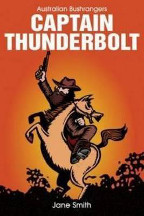Australian Bushrangers series by Jane Smith

Big Sky Publishing, 2014
Captain Thunderbolt. ISBN 9781922132574
Ben Hall. ISBN 9781922132697
Captain Starlight. ISBN 9781922132710
Frank Gardiner. ISBN 9781922132673
Captain Moonlite. ISBN 9781922132581
Themes: Bushrangers; Australian History. This series is written in a
simple style with some sidebar excerpts to fill in detail. The index
would enable the text to be used by young students for research, but
the books in this series are easy to read from cover to cover and
could even become teacher-shared texts during a unit of work on
early Australian History during the mid-1800s. Inferences about what
life was like during this period could also be made (in connection
with Year 5 Australian Curriculum History content.)
Captain Thunderbolt
This short biography and detail of the exploits of 'Captain
Thunderbolt' (Frederick Wordsworth Ward) gives an overview of his
life and his career on the wrong side of the law. Thunderbolt is
represented as a 'gentleman' rogue who enjoyed support from the
wider public despite his attempts to improve his own circumstances
by thieving. Smith gives brief accounts of the chronology of his
life and deeds and the book includes some evidence of Primary
sources for the historical account.
Ben Hall
Ben Hall, another 'gentleman' bushranger, who despite being the
child of ex-convicts, appeared to have a more promising future until
he met up with the notorious bushranger Frank Gardiner. This book
details the robberies of Ben Hall and the changing faces in his gang
in the 1860s. The circumstances that led to his notoriety and the
ultimate outcome of his life of crime are well detailed by the
author, with sketches, primary sources and photographs used to
illustrate the text.
Captain Starlight
This book focuses on two bushrangers, Frank Pearson and Harry
Readford, who might potentially have inspired the character Captain
Starlight from the Rolf Boldrewood book Robbery Under Arms
(published in 1888 after first appearing as a serial in a Sydney
newspaper). Both bushrangers were well read, and may have been
successful if they had not sought an 'easier' route by breaking the
law and attempting to make easy money via criminal means. Although
the author does not speculate about society at the time, it is
apparent from their crimes, that the two 'Captain Starlight'
characters sought to exploit the wide and poorly policed areas of
New South Wales and Queensland in the 1800s. The legal system also
was well exploited by these lawbreakers. The author has made brief
comparisons between Pearson and Readford, but has also indicated how
they pursued their crime path in some detail.
Frank Gardiner
Frank Gardiner was notorious, leading a life of crime that involved
theft, highway robbery and attacks on the police who came to arrest
him. Mid-19th century life was tough in the rural regions of NSW,
and even those who were attempting to live honestly were tempted to
make their way by illegal means. The police were not well-respected
because they represented the authority of the government which was a
target for many who had come to hate taxes and their impoverished
existence, and the added influence of convict heritage may have had
its own impacts. Into this environment, the well-spoken and affable
Gardiner (aka Christie) was easily able to draw a collection of the
disaffected and pursue a career of crime. This book details his
pursuits and explores why he was respected and protected by many of
the local citizens of NSW despite his illegal activities. This is an
interesting stand-alone book, but together with the rest of the
series gives an insight into early life in the colony.
Captain Moonlite
Andrew George Scott became known as 'Captain Moonlite', who despite
coming from a good family and having a religious background, ended
up on the wrong side of the law. Scott was educated and had
prospects for a career in the developing colony (after migrating
from Ireland via New Zealand). A hold-up in the local bank
implicated Scott and a pathway of lies and deceit revealed Scott as
a complicated man with a tendency to performance. The web of
intrigue tightened around him and his prison experiences impacted
his life. He had a complicated and high view of his own opinions (he
would defend himself in court with dramatic fervour and went on a
speaking tour to promote prison reform) and was also able to
convince others to follow his instructions. Although a 'gentleman',
he was not as amiable in his approach as other bushrangers in this
series and there could also be some conjecture about his mental
stability and his possible homosexuality. The fact that jobs were
hard to find for those who had served jail sentences created a
desperation that led to his short-lived bushranging career which
ended on the gallows. This book reveals a complex character and a
complicated set of circumstances and although the social context is
not examined in detail, gives hints about how bushranging became a
choice for Captain Moonlite and his less well-known companions. This
is perhaps less likely to be used as a read-aloud text for Year 5
students as part of the Australian Curriculum - the behaviour of
Captain Moonlite is harder to fathom for a younger audience.
Carolyn Hull